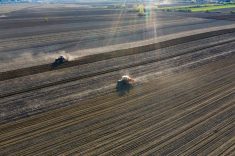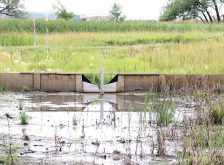One man’s trash is another’s treasure. It’s a familiar idiom at the heart of a Canadian company’s process for turning municipal sewage into fertilizer.
Faced with the challenge of dealing with sludge, Canadian municipalities have done everything from dumping it in landfills to letting it flow into the ocean.
Lystek International, based in Cambridge, Ontario, has a different solution. The company’s facilities transform a municipality’s waste into a pathogen-free, CFIA-registered fertilizer.
The final product, LysteGro, contains a whole suite of macro- and micronutrients, says Mike Dougherty, an agrologist and fertilizer sales manager for Lystek.
Read Also

Claas brings 1000 Series SP forage harvesters to Canada
In mid-August, Claas unveiled its new line of Jaguar forage harvesters at an event in Visalia, California, deep in the heart of that state’s dairy region.
“The majority of the nitrogen is in inorganic form, so it will be released slowly over the year through mineralization,” says Dougherty. That late-season nitrogen availability is a strong selling feature for high-nitrogen crops such as canola.
LysteGro is sold as a liquid. Per 1,000 gallons, it contains the following nutrients:
- 42 lbs. of nitrogen
- 40 P2O5 (phosphorus)
- 60 lbs. K2O (potassium)
- 7 lbs. sulphur
- 16 lbs. calcium
Dougherty says it also contains magnesium, zinc, copper, iron and other micronutrients. The organic matter concentration is approximately 10 per cent on a wet weight basis, or about 65 per cent of the product on a dry weight basis.
Lloyd Brubacher works for Highland Custom Farming at Grand Valley, Ontario, north of Toronto. Highland Custom Farming has been applying LysteGro on its own land, and also for other farmers, for four years.
Brubacher says his boss had another company custom-apply LysteGro to his farm the first year. After seeing the results, “we couldn’t say no to it. The boss went out and bought his own equipment after he’d seen the final results.”
LysteGro has been a great help to farmers in his area, Brubacher says. “This stuff really brings the yields back in a hurry.”
Brubacher says LysteGro is a “very universal” fertilizer that they apply to a range of annual crops. “We’re starting to go into the grass fields as well, after first cut.” Brubacher adds they’re now seeing more yield from the second cut than the first.
Dougherty puts the price at $30 per 1,000 gallons applied. At agronomic rates of application, no commercial fertilizer is required, although starter is sometimes used.
Farmers are mainly interested in the nutrient concentrations, organic matter, and other micronutrients, says Dougherty. “Soil health is becoming a bigger and bigger factor so a lot of guys are looking at any kind of organic amendment they can get, whether it’s LysteGro or compost or manure or other materials.”
LysteGro needs to be injected below the soil’s surface. That requires higher-end liquid manure injection equipment, says Dougherty.
The last few years of applying LysteGro have taught Brubacher a few things. One point is that the product will dry out if exposed to open air. If weather prevents application, and you don’t want to unload it from the tank, you’ll need to keep it covered.
But LysteGro does expand, so the tank needs to be vented, Brubacher says. Otherwise, “if you have everything closed-off, air-tight, it will find the weakest spot and blow out.”
Dougherty says application frequency will depend on soil sample results and cropping plan. They often apply LysteGro to a field for two years, and skip the third year.
How much fertilizer a plant produces varies between locations, Dougherty says. Lystek’s main processing facility in Ontario produces roughly 20 million gallons a year. The North Battleford plant, which opened in December 2014, produces nearly a million gallons of LysteGro.
Before installing the Lystek system, North Battleford sent its waste to a landfill. In 2015, the City received an environmental award from the Canadian Association of Municipal Administrators for its Lystek system.
Brubacher says options like Lystek’s system will continue to grow. “It just takes time for people to wrap their heads around everything.”
















